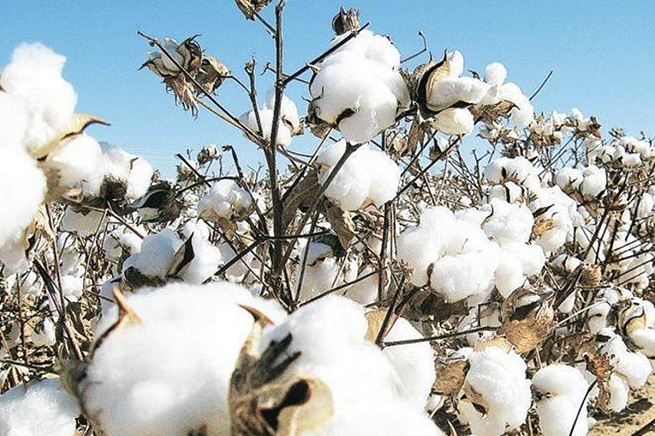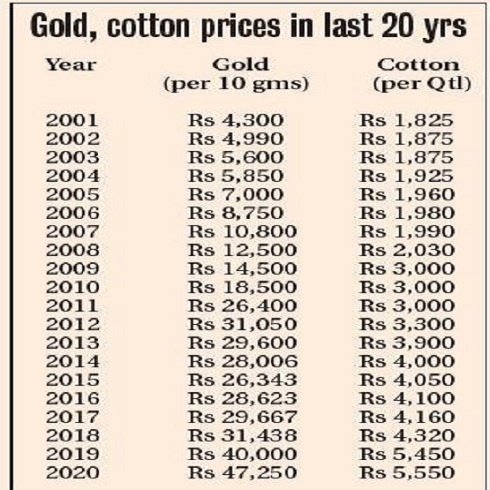In 20 yrs, Yellow Metal robs White Gold of its shine
| Date :04-Jun-2020 |

By Kartik Lokhande :
Price of one quintal cotton comes down to only 11.64% of that of 10 gms gold
A FEW days ago, news came that the Government hiked minimum support price (MSP) for cotton from Rs 5,550/- per quintal to Rs 5,825/- per quintal. For people unaware of the prices of agricultural commodities like cotton, this is a ‘good’ increase. However, for those in the know of things, the increase in MSP for cotton in the past 20 years has actually not been commensurate with overall market. Traditionally, comparisons have been drawn between the average prices of 10 grammes of ‘yellow metal’ (gold) and a quintal of ‘white gold’ (cotton).

The data of average prices of these two commodities since 2001 indicates that though gold prices have increased by around 11 times, cotton prices have increased by slightly above three times. The gold prices have soared from an average Rs 4,300/- per 10 gms in 2001 to Rs 47,250/- per 10 gms in early part of 2020. Whereas, cotton prices have increased from Rs 1,825/- per quintal in 2001 to just Rs 5,550/- per quintal in early part of 2020. If comparisons are to be drawn between ‘white gold’ and ‘yellow metal’, the average per quintal price of cotton was 42.44 per cent of that of 10 gms of gold in 2001.
While the cotton prices stayed stagnant up to 2003, the gold prices registered steady increase. In 2003, the price of 10 gms of gold was Rs 5,600/-. In 2007, the price of 10 gms of gold was Rs 10,800/-. However, that of cotton was just Rs 1,990/-. Thus, in 2007, the price of a quintal of cotton was 18.42 per cent of the price of 10 gms of gold. Since then, whenever the share market was ‘volatile’, price of gold kept on increasing as people resorted to traditional mode of investment -- buying gold.
However, in case of cotton, market volatility hit the commodity hard. In 2011, the gold price rose to Rs 26,400/- per 10 gms. In the same year, however, a quintal of cotton fetched an average Rs 3,000/- for farmers. Thus, in 2011, price of one quintal of cotton was 11.36 per cent of that of 10 gms of gold. Between 2009 and 2011, average cotton price remained at Rs 3,000/- per quintal but that of gold kept increasing steadily. There was a period when gold prices dipped and cotton prices continued registering increase steadily. In 2013, gold price came down from Rs 31,050/- in 2012 to Rs 29,600/- per 10 gms. However, cotton price increased from Rs 3,300/- per quintal in 2012 to Rs 3,900/- per quintal in 2013. In 2013, cotton price was 13.17 per cent -- a marginal improvement -- of gold price. In 2015, average price of 10 gms of gold was Rs 26,343/- and that of cotton was Rs 4,050/-. Thus, cotton price was 15.37 per cent of gold price that year.
But, since 2016, gold and cotton prices continued increasing till date. But, as in early part of 2020, gold was at Rs 47,250/- per 10 gms and cotton was at Rs 5,550/- per quintal. Commenting upon the situation, Anantrao Deshmukh, Chairman of Maharashtra State Co-operative Cotton Growers’ Marketing Federation, told ‘The Hitavada’ that the input cost of crop should be considered while deciding MSP. “Over the years, there has been increase in input cost of various crops including cotton, but there has not been commensurate rise in MSP. As a result, over the years, the disparity between price of 10 gms of gold and one quintal of cotton has increased,” he said.
‘Consider increase in farmers’ income while deciding prices of crops’ Commenting upon the situation Vijay Jawandhiya, an activist fighting for farmers’ rights for past several years, said that the increase in farmers’ income should be considered while deciding prices of agricultural commodities. Recalling his farming days, Jawandhiya said that cotton price was Rs 250/- per quintal in 1972 and gold also was priced at Rs 250/- per 10 gms. “Then, a farmer could buy 10 gms of gold by selling one quintal of cotton. Today, on an average, a farmer has to sell eight quintals of cotton to buy 10 gms of gold. This explains the situation,” he told ‘The Hitavada’. Similarly, in 1972, he sold jowar at Rs 150/- per quintal. Today, he said, one will have to sell 18 quintals of jowar to buy 10 gms of gold. The prices of agricultural commodities are decided by international factors since globalisation and liberalisation, Jawandhiya observed. While the subsidy to agriculture has not decreased in developed countries, developing countries like India were unable to give that much subsidy to agriculture sector. This has led to decline in wages of farm workers apart from impact on prices of agricultural commodities. Agriculture sector’s contribution to India’s GDP has come down from 48 per cent once upon a time to 14-15 per cent nationally and 12 per cent in Maharashtra, he said. According to Jawandhiya, Swaminathan Commission’s major recommendation was that the agricultural growth should be measured in terms of increase in income of farmers instead of increase in agricultural production. “This has to be recognised while deciding prices of agricultural commodities,” he demanded. Besides, if price of 10 gms of gold is considered as a measure while effecting increase in salaries of organised sector, the same standard should be applied while deciding wages of farm workers and prices of agricultural commodities, he stressed.
